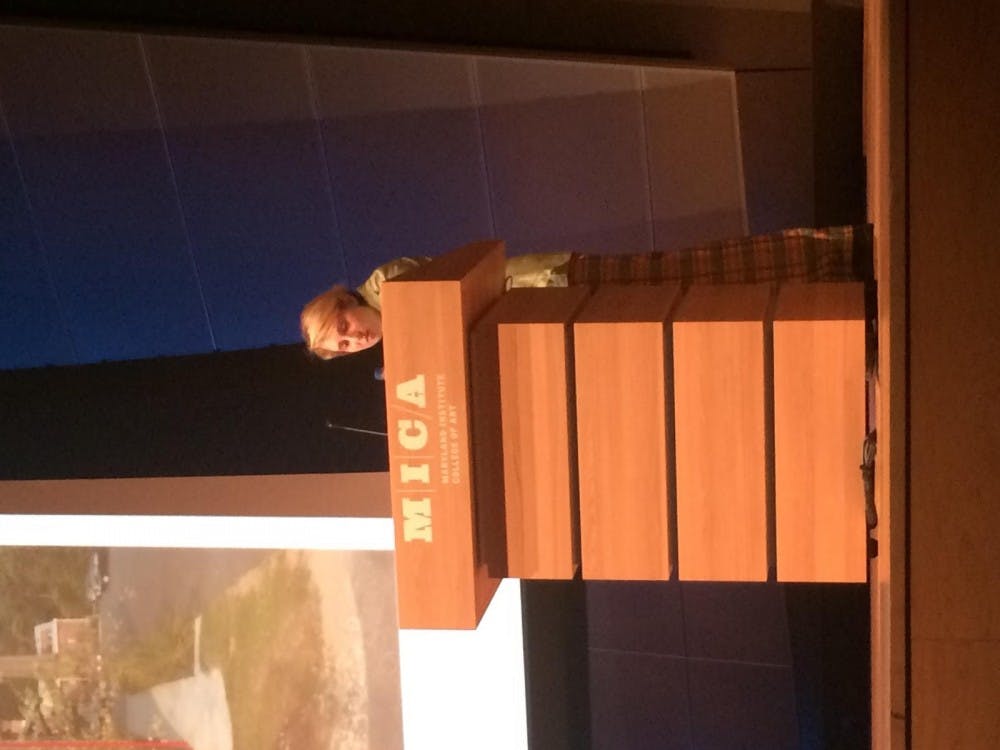Peabody alumna Kate Wagner spoke at Maryland Institute College of Art’s (MICA) Brown Center to kick off Doors Open Baltimore, a free citywide celebration of Baltimore’s architecture and neighborhoods. The event took place on Thursday, Oct. 4.
Wagner is the author of McMansion Hell, a viral blog that takes McMansions to task by roasting them from top to bottom. The photos, picked from Zillow, are covered in snarky comments that point out the flaws in the logic of the world’s ugliest houses and end up teaching a little something about architecture and design.
The blog has grown into something huge for Wagner, attracting the attention of architects and designers nationwide. Wagner now writes about architecture for publications like The Atlantic, 99 Percent Invisible, Paper Magazine and Slate. Recently she’s started doing talks that provide people with language that enables them to be critics of the houses that surround them.
At the event, Wagner stood at a podium, which she said was obstructing her funky chartreuse 70s suit and ran her laser pointer over the PowerPoint slides. She introduced architectural concepts and walked through them with example pictures of Baltimore houses and buildings. Wagner spoke lovingly of the buildings in her photographs — pictures she’s snapped on walks around the city, mostly from around the Charles Village area.
“I love this little block,” she said of the 700th block of West Monument Street, featuring little yellow row houses squished together. “Look how adorable and small.”
Wagner started by teaching general words like “masses,” the blocks that make up and attach to a building, and “voids,” empty space on a building like parking garages or “anything that bugs can get into.” She moved into talking about balance, proportion and rhythm, and explains this is essentially the relationship of parts of a building on either side of an imaginary line.
“If you stare at a building long enough and something looks suspicious, it’s probably not proportional,” Wagner said. “That’s why McMansions are so bad. There’s so much ‘hmmm.’”
She pointed out that there aren’t many McMansions in Baltimore since most of the city’s buildings were built between the 1800s and 1920s.
She moves on to talk about the parts of the house. “Here are some words you can use so you don’t point at the gable of a building and call it ‘the little roof hat,’” she said.
She explained words like “facade” and “elevation” (architectural words for the front and sides of buildings) and roof words like “dormer” and “gable,” the latter being the triangle intersection above walls under a pitched roof that does, in fact, look like a little roof hat.
Wagner lingered on the Baltimore specific features, too.
“Yay! The stoop. We love the stoop. Sit outside, drink a beer. Actually, I think I’m getting too old for the stoop,” she said.
Wagner then explained the difference between a row house and a townhouse. A row house, she said, is a house that’s attached to other houses in a row and “90 percent of what you see every day in Baltimore.”
A townhouse is a more general term often used in D.C. to describe houses that look like row houses but are actually detached. If people are confused whether to classify a building as a row house or a townhouse, Wagner joked that people should say “row house” to be loyal to Baltimore.
Wagner also explored the styles of row houses that make up different parts of the city: the early and squat row houses in West Baltimore, the tall brick Italianate row houses in Remington and the mishmashed, artsy and eclectic row houses of Charles Village.
Wagner ended the talk by asking the audience to go out and appreciate the buildings and histories around them.
“The best way to look at a building is to just go sit there and look at it for 20 seconds and think ‘something ain’t right’ or ‘something is right, and why do I like this so much?’” she said.
For Wagner, architecture and buildings are deeply personal and allow her to think about the stories they contain.
“I like looking at buildings because I think they tell us something about people, and I think they tell us something about the way people have lived, do live or want to live. If you learn how to pick things out and try and put names to faces, then that’s one step to building a broader relationship with architecture,” Wagner said.
Wagner is a current Baltimorean, Charles Village-ite and recent graduate of the Hopkins Peabody Institute, where she studied acoustics. She has no formal education in architecture.
“I don’t have a degree in architecture and I’m here talking to you about it. That should be an important testament to the power of reading,” Wagner said.





